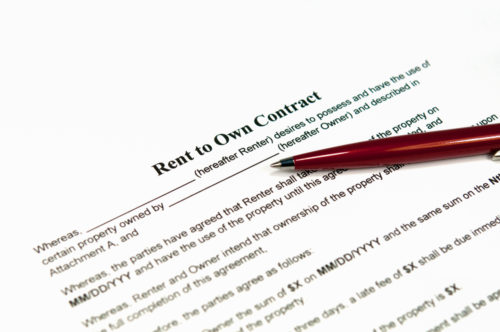In some cases, people can’t afford the monthly mortgage payments required to purchase a home, but they don’t want to dump all of their investment into a rental property they’ll never own. That’s where rent-to-own homes come in.
The concept of renting something until you’ve paid enough to own it dates back to the 1950s, when businesses would rent appliances to consumers to keep continuous cash flow moving through the business. Business owners were able to earn a profit and sell merchandise, but without the risk of the consumer defaulting on payments. But this business model worked for consumers, too, because they could get more expensive items home at a lesser cost and eventually own the item.
If you’re wondering whether renting or buying a property is right for you, you might consider a rent-to-own property. This concept is still a viable option for many consumers today, especially when it comes to buying a big-ticket item like a house. If you’re interested in purchasing a home, rent-to-own could be the best choice. Learn more about how rent-to-own homes work and the pros and cons of this option.
Table of Contents
What Is a Rent-to-Own Home?
A home that is rent-to-own is owned by a landlord who rents it out for a certain amount each month with the option for the renter to purchase the home at the end of the lease. In other words, the person renting the home makes payments that go towards the mortgage payment of the property.
How Does It Work?
A tenant signs a lease that includes an option to buy the property once the lease is up. The payments made each month by the renter include the rental fee and any additional amount the owner of the property requests that will later go towards the down payment of the home.
When the lease comes to an end, the renter can purchase the property from the owner for the price identified in the lease. The lease’s terms include information on the down payment and what the monthly mortgage payments will look like.
Below, we’ll dive into greater detail and explain exactly how rent-to-own homes work.
Lease With Option to Purchase
If you rent a property that has a lease with an option to purchase, you have the right to purchase the home when the lease concludes. While you’re able to purchase the home, it’s not required that you do so.
Lease With Purchase Agreement
Unlike leases with an option to purchase, a lease that includes a purchase agreement guarantees that the renter will purchase the home at the conclusion of the lease. Renters who enter into this kind of agreement should have a professional home inspection done prior to becoming the owner.
Purchase Price
The price the home is purchased at may vary depending on the agreement. For example, the price may be determined by the owner of the property or it might be negotiable. Regardless of what the purchase price is, it should be clearly outlined in the contract how the price will be determined at the end of the lease.
Fees
A range of fees can be included in a rent-to-own agreement. First and foremost, there is usually a nonrefundable upfront fee that allows you to buy the house at a later date. This option fee is often negotiable, though. Additionally, there may be fees for things like homeowner’s associations or fees for repairs that need to be made to the home, as there would be with a rental property.
Maintenance
As with traditional rental agreements, the maintenance covered in a rent-to-own agreement may vary. Often, the current owner of the property is responsible for maintenance and upkeep while they own the home. Once the home is purchased by the renter, maintenance becomes their responsibility. The rent-to-own agreement should clearly outline who is responsible for maintenance and when.
Length of Rental Term
Again, this will vary with each owner-tenant relationship, but typically a lease is one year long. Some owners will offer a month-to-month lease. Regardless of what the term might be, it should be clearly outlined in the rent-to-buy agreement.
Applying for a Mortgage
When it comes time to purchase the rent-to-own property, you’ll need to apply for a mortgage. As a current tenant, you’ll want to do this as close to the end of your lease as possible. To apply for a mortgage, you’ll need current versions of your:
- Credit report.
- Income.
- Assets.
- Proof of employment.
- Identity.
Ideal Rent-to-Own Candidates
Whether you need to save money for a down payment or need time to improve your credit score so that you can obtain a loan with a better interest rate, rent-to-own candidates each have their own reasoning. Renting prior to owning can be ideal for people who want to become a homeowner but aren’t financially ready yet. Ideal rent-to-own candidates should be confident in their ability to close a purchase once their lease concludes. Otherwise, the option fees and monthly rental payments are all for naught.
Why Should I Consider Renting My Home Prior to Owning It?
There are many reasons someone might choose to rent a home prior to purchasing it, including:
- You can’t afford a mortgage payment.
- You can’t obtain a mortgage right now.
- You can lock into a purchase price.
- You can build equity.
- You can test out a neighborhood, school district, or workforce.
Advantages of Rent-to-Own Homes
Rent-to-own homes offer several different advantages for both the sellers and buyers.
Advantages for Sellers
- You can attract more buyers. Not everyone qualifies for a loan, but they may be able to in the future with a rent-to-own agreement.
- You can earn an income. If you don’t have to sell your property right away, you’re still able to turn a profit on the property while waiting for your tenants to move towards buying. Plus, you can often ask for more money when it comes time to sell in a rent-to-own agreement, resulting in a higher profit.
- Your property will be taken care of. You won’t have to worry as much about damage to the property with a rent-to-own tenant. Because the home is their investment, they’re more likely to take care of it.
Advantages for Buyers
- You can purchase a home with a poor credit score. Renting to own gives you time to save money and work on improving your credit score so you can obtain a mortgage at a rate that works for your budget.
- You can lock in a purchase price. If the home market’s prices are on the rise and you don’t want to wait to buy a home, renting to own allows you to secure a property and prevent the cost of the home from increasing in the next year or so.
- You don’t have to commit. If you aren’t sure about a neighborhood or school district, renting to own allows you to “test-drive” a neighborhood before you commit to living there. In addition, you’re also saving on moving costs if you decide to stay.
- You can build equity. While renters don’t build equity the same way homeowners do, the payments made each month accumulate to a substantial sum that can be put towards your purchase of the home.
Disadvantages of Rent-to-Own Homes
Rent-to-own homes also have several disadvantages for both the sellers and buyers.
Disadvantages for Sellers
- You lose out on money. Sales prices are generally locked in with rent-to-own agreements, but the value of the property could rise during the time the tenant is renting. Similarly, the renter could choose not to buy, but the home market could be bad and the property is not valued as highly as it may have been previously.
- The renter decides not to buy. There are many reasons they might do this, including finding a better option elsewhere, finding flaws in the home, or not being able to obtain a mortgage.
Disadvantages for Buyers
- You could lose money. If you choose not to buy the property, you lose out on the investments you were making each month.
- You may not be able to increase your credit score. Sometimes, it’s not possible to increase your credit score or earn more money within the timeframe of the rent-to-own agreement.
- You don’t have control over the property’s finances. If your landlord stops making mortgage payments, the home could go into foreclosure and there’s nothing you can do about it. Additionally, your landlord could cause other problems by not paying their property taxes or not keeping up with general property maintenance.
- Home prices could fall. By the time you decide to buy the home, the housing market could have more affordable prices elsewhere, but you’ve already dumped a significant amount into your rent-to-own home.
- You might pay late and incur late fees. Certain rent-to-own agreements will outline a fee for late payments. Similarly, late payments could damage your right to purchase the home.
- The property could have issues. From minor repairs to cracks in the foundation, there could be major problems with a rent-to-own property that aren’t visible to the naked eye. A thorough home inspection can help negate these issues.
- The agreement could be a scam. Rent-to-own scams are all too common, especially amongst people struggling financially.
Wondering whether you should rent or buy your home? Consider a rent-to-home property.
Image Source: https://depositphotos.com/





